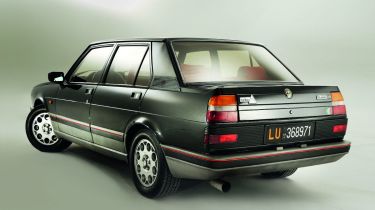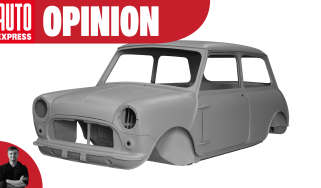Alfa Romeo Giulietta (1977-85)
The late Seventies Giulietta took a very different direction in terms of style from the iconic original, and although hardly beautiful, but the rare Turbodelta version in our pictures is seriously quick.
The late Seventies and early Eighties heralded a new approach to car design, and the 1977 Giulietta was a world away from the pretty original. It was designed to replace the legendary Giulia saloon, and shared its chassis with the existing four-door Alfetta. A low nose and high tail gave the car a wedge-like appearance, and its boxy proportions and matt plastics were in direct contrast with its chrome-laden Fifties inspiration.
Period exterior details include chunky push-button door handles and grille vents on the C-pillars, which incorporated the fuel filler cap. Look closely and you’ll also spot the neatly integrated spoiler on the trailing edge of the bootlid. The net result is far from pretty, but the rarity value and classic design cues give the second-generation Giulietta real appeal.
Its dated roots are even more obvious inside, where the graphics for the anti-clockwise rev counter, plus the roller-style gauges for the fuel level and engine temperature, are pure Eighties. As its underpinnings were borrowed from the five-year-old Alfetta, the second-generation Giulietta was low on technological innovation, but its front-engined/rear-mounted gearbox layout optimised the weight distribution to aid handling.
The car in our pictures is the rare Turbodelta version. It debuted at 1982’s Paris Motor Show, and was built for homologation purposes. The racing project never got off the ground, though, and only 361 were made. All were left-hand drive, with black paintwork and contrasting red cabin trim (including the rooflining).
Used - available now

2022 Nissan
Qashqai
24,158 milesManualPetrol1.3L
Cash £14,097
2022 Nissan
Qashqai
33,104 milesManualPetrol1.3L
Cash £13,397
2021 Skoda
Kodiaq
49,860 milesAutomaticPetrol1.5L
Cash £17,197
2018 Audi
A3 Sportback
31,256 milesAutomaticPetrol1.5L
Cash £17,197A turbocharged 2.0-litre powerplant developed by in-house tuning brand Autodelta provided the car with lively performance – even by today’s standards. It could sprint from 0-60mph in around seven seconds, while uprated brakes and suspension ensured stopping power and handling to match the straight-line pace.
Sporty additions inside include a Momo sports steering wheel and boost pressure gauge in place of the air vent in the centre of the dash. The top-spec version of the modern Giulietta shows this data on a pop-up digital screen!
Lesser models featured a range of petrol engines originally carried over from the Giulia saloon. They ranged in size from 1.3 and 1.6 litres to 1.8 and 2.0 litres. The firm even produced more than 17,000 examples equipped with a 2.0-litre turbodiesel developed by Italian specialist VM.
While you could never describe the Eighties Giulietta as pretty, nor a huge sales success in the UK, it still bore the hallmarks of the brand – with its entertaining driving dynamics and characterful engines. The company had shifted nearly 380,000 examples by the time the car was axed in 1985 – when it was replaced by the even more daring Alfa 75 – so it outsold the legendary original by nearly three to one.



